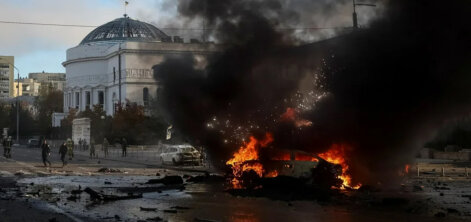The Russian Federation launched a massive missile attack on Ukrainian territory. Among the targets: residential buildings, playgrounds, intersections, hospitals, universities of peaceful Ukrainian cities.
Chronology of shelling of Ukrainian cities:
Zaporizhzhia:
On October 9, Zaporizhzhia was subjected to massive shelling. A nine-floor building was destroyed in the city. 13 people died, more than 80 were injured.
On October 10, Russia launched about a dozen missile strikes on Zaporizhzhia. The invaders destroyed a residential multistory building in the city center. This was announced by the head of the Zaporizhzhia OVA, Oleksandr Starukh. The invaders attacked the city at about 1:50 a.m.
Mykolaiv:
On October 10, the head of the military administration of the Mykolaiv region, Vitaly Kim, reported that on the night of October 10, the Russians launched 10 S300 missiles at Mykolaiv. A hit was recorded on the territory of the university and warehouses, a residential building and a power line were damaged.
Kyiv:
On the morning of October 10, several series of rocket attacks were carried out in the capital.
Around 9 a.m., a shell fell near the Grushevsky monument on Volodymyrska Street in the center of Kyiv. The rocket flew into the usual crossroads near the Teacher's House, nearby the monument of Grushevsky. As a result of the strikes, there are dead and injured. Preliminary, it is about 30 victims.
The rockets hit the hillside near the footbridge, as well as a playground in the city center.
According to Vitaliy Klitschko, the mayor of Kyiv, Russian missiles also hit facilities in the Shevchenkivskyi and Solomianskyi districts of the capital.
Dnipropetrovsk region:
On October 10, more than 30 multistory and private houses, outbuildings, cars, gas pipelines and electrical networks were damaged in Nikopol. The houses of more than 2,000 people have been de-energized.
Russian shells also hit a hospital, a lyceum, a post office, a pharmacy, an insurance company office, a library, shops, restrains, a hairdresser, and a parking lot.
In the Kryvyi Rig region, the enemy “Hurricanes” hit the Zelenodolsk community. People were not hurt. The extent of the destruction is being ascertained.
In the morning, information appeared about a series of explosions in the Dnipro. Local Telegram channels wrote about the explosions in a residential area. The scale of the consequences is being investigated.
The missile attack of the Russian Federation on the morning of October 10 covered other cities of Ukraine. Explosions thundered in Lviv, Khmelnytskyi, Zhytomyr, Kharkiv, Kremenchuk, Vinnytsia.
In Khmelnytskyi, Zhytomyr, Lviv, the light disappeared in many districts of the city after the shelling. And in Poltava, light and water disappeared. Three blows were dealt on Kharkiv, electricity and water were lost in some areas.
Context:
Over the past two days, Russian missiles have flown into the center of Kyiv, residential buildings in Zaporizhzhia, Nikopol, as well as infrastructure facilities in many Ukrainian cities. Among them: Zhytomyr, Lviv, Dnipro, Kharkiv, Kremenchuk, etc.
To counter this attack, the world must recognize Russia as a terrorist country. In addition, Western countries should support Ukraine with the supply of more weapons. Among which are air defense systems, long-range missiles, as well as aviation.
Recall that the tactics of terror against civilian infrastructure during the conduct of hostilities is not new. During the Second World War, the Nazis destroyed several Eastern European cities. In 1941, during the six-day strikes of the German bomber German aviation, 80% of the residential buildings of the city of Minsk were destroyed, the central district of the city and the railway junction were destroyed, 313 out of 330 industrial enterprises were destroyed.
During the street battles of the Warsaw Uprising, between 25 and 30% of the housing stock of the Polish capital was destroyed. After the surrender of the Polish forces, the German troops purposefully razed another 35% of the city’s buildings. Later, these actions were recognized as violations of the laws of war and crimes against humanity.
The most famous case of the destruction of the entire city before the start of World War II was the bombing of the Spanish Guernica by fascist aircraft in 1937. The bombings destroyed most of the city, and the fire that followed them caused a large scale of destruction (at least 75% of the city's buildings). Impressed by the scale of the destruction, Pablo Picasso painted his famous painting Guernica.
